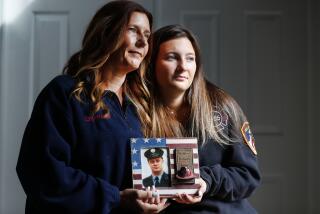1 World Trade Center: A high-tech ride symbolizing New York’s resilience

Inside One World Observatory
Reporting from NEW YORK — From the bedrock of lower Manhattan, a new tower has risen to claim a place of prominence in an ever-resilient city.
Such is the message driven home during the slick, high-tech presentation that accompanies a visit to the new observation deck at 1 World Trade Center, the 1,776-foot, recently completed office tower that is the city’s tallest building.
Friday’s opening of One World Observatory on the 100th, 101st and 102nd floors is a milestone in the years-long redevelopment of the site that once housed the twin towers, destroyed in the terrorist attacks of Sept. 11, 2001.
For the first time since the attacks, the general public will be streaming into a World Trade Center skyscraper and speeding to the top in elevators — 47 seconds from below ground to the 102nd floor — to take in spectacular views of the metropolis and beyond.
Though the events of Sept. 11 are not ignored, the focus of the new observatory’s “experience” is very much on renewal and celebrating New York and all its offerings.
“We want that fist-punch moment that says, ‘We’re back,’” said Dave Kerschner, president of attractions for Legends, the company that operates the new observatory.
That “ah-ha” moment comes during a choreographed presentation before anyone even steps foot into the observatory.
Upon arrival, visitors descend into a white marble lobby for security checks. From there, they enter a welcome hall where a huge interactive map of the world displays real-time data on visitors’ home states and countries scanned from their ticket stubs.
Visitors then move into a darkened corridor lined with video screens playing snippets of interviews with construction workers, architects, planners and other people who were involved in the building of 1 World Trade Center. This is one of the few times Sept. 11 receives mention, when many of the workers describe how meaningful it was for them to be part of the rebuilding effort.
The corridor continues through a section of exposed granite bedrock on which the skyscraper is secured, ending at a bank of elevators, which Legends says are the fastest in the Western Hemisphere.
The theme of an ever-changing, vital city is introduced during that quick ride to the top. Three sides of the elevators are lined floor to ceiling with LED screens that show a time-lapse video of what New York looked like from the 1500s until now. Scenes of bucolic village life of the city’s origins dissolve into the bustling immigrant center it was in the 19th and early 20th centuries into the early skyscraper era to present day.
Briefly, the old World Trade Center buildings are seen on the right-side screen. “The twin towers appear and disappear at the appropriate time,” Kerschner said.
At the entrance to the observatory, visitors enter a long, narrow room in which they face a wall with yet more screens. A montage of New York scenes — pedestrians pounding the pavement, the lights of Times Square, Chinatown, the High Line park, an iconic water tower — plays to music. Then, the sensory overload stops.
It is quiet and the wall of screens rises like a curtain in front of a stage to reveal the first view — looking north up the island of Manhattan.
There it is, the “ah-ha” moment.
Once upstairs, visitors can roam the main observatory floor with its 360-degree views of the city, grab a bite in one of three restaurants on the 101st floor that are open only to visitors who paid the observatory’s $32 entrance fee or step on the Sky Portal, a round glass floor under which is played live-streamed video of the street scene below taken from cameras attached to the building’s spire.
For the people who have been overseeing the redevelopment of the 16-acre World Trade Center site, the observatory’s opening is one step in many over the last few years — the creation of the memorial pools in the footprints of the former towers, the opening of the National September 11 Memorial and Museum, the construction of 4 World Trade Center, another office tower, and the arrival of the first tenants to 1 World Trade Center.
The observatory “brings closure on 1 World Trade Center,” said Patrick Foye, executive director of the Port Authority of New York and New Jersey, the public agency that owns the site and sees this as part of the city’s revival.
That more work is still to be done was evident during a walk through the area. Workers on cherry pickers painted the giant spikes protruding from the Santiago Calatrava-designed transit hub, set to open in stages this year.
Steelworkers welded supports on 3 World Trade Center, the next high-rise to go up on the site, and yet more work continued on the fortified vehicle security building being constructed on the southern border, which will have a rooftop park.
Steven Plate, director of World Trade Center construction at the Port Authority, said the new observatory also brought back a cherished place for New Yorkers, who used to go to the old World Trade Center observation deck to celebrate anniversaries and weddings and to make marriage proposals.
He had just such an experience. In 1975, Plate said that for their first date, he took the woman who became his wife to Windows on the World, the former restaurant atop the original World Trade Center.
“It was the middle of winter and it was snowing and we went to the bar,” he reminisced. “And now we’re going to go back.”
More to Read
Sign up for Essential California
The most important California stories and recommendations in your inbox every morning.
You may occasionally receive promotional content from the Los Angeles Times.










